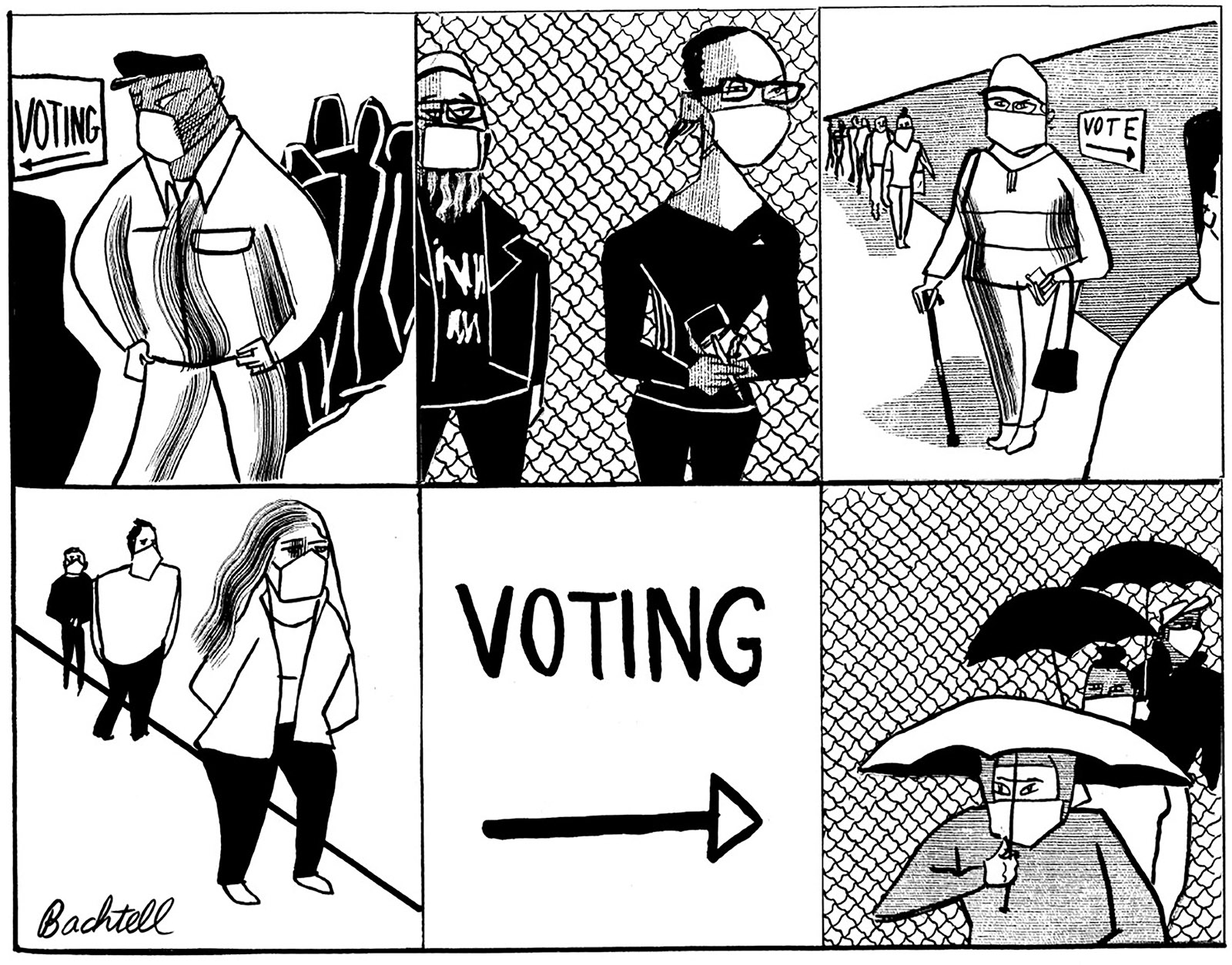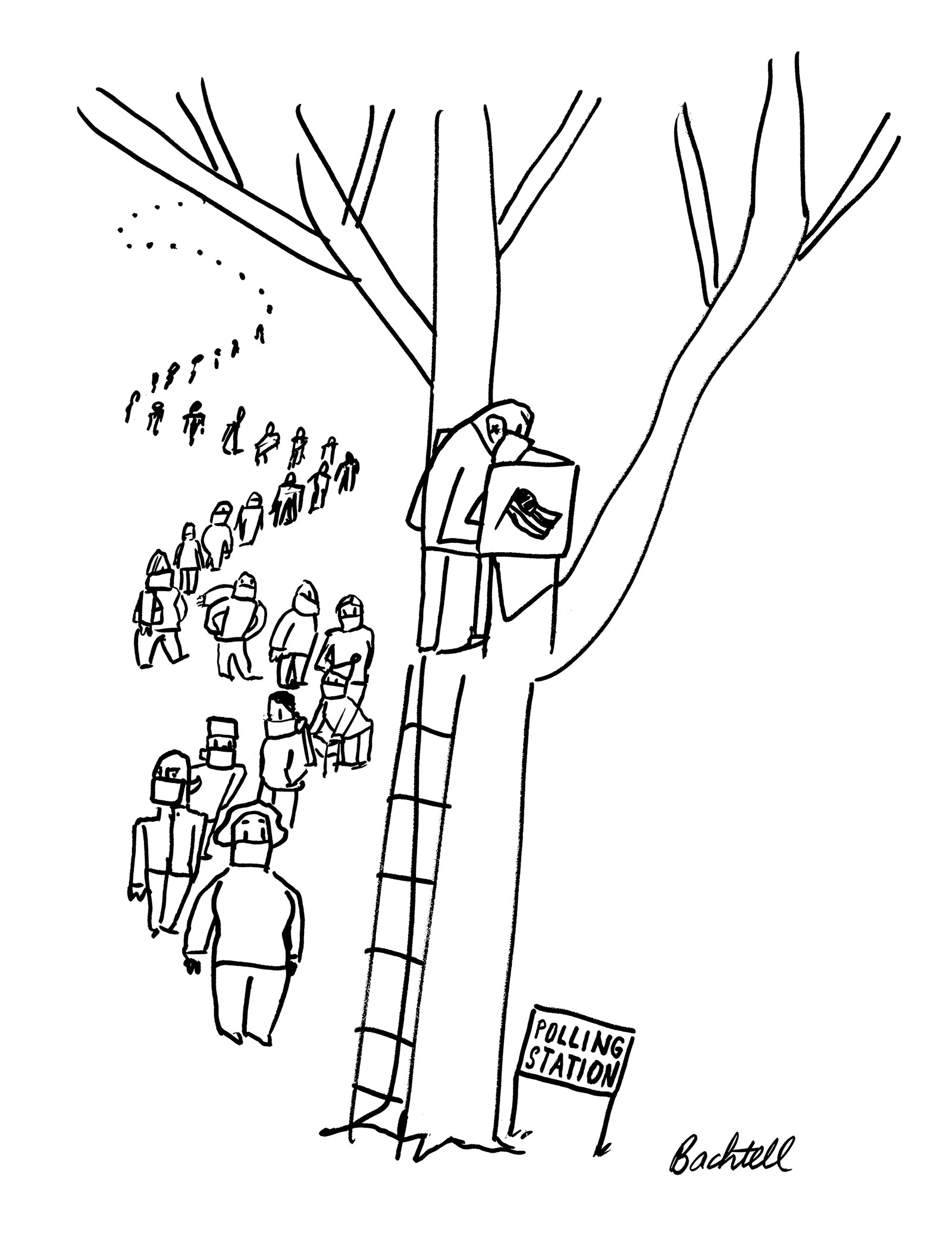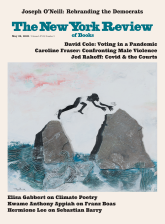Nothing symbolizes democracy like long lines at the polls on election day. They represent a collective act of faith, as chances are virtually nil that any one of the votes we cast over our lifetime will determine the outcome of an election. They remind us that many of our fellow citizens have had to fight to stand in such lines. And because long lines are also often a sign that election officials have failed to provide sufficient voting opportunities, they illustrate the tenacity of citizens who insist on casting their ballots even when the government seems more interested in obstructing than in facilitating the franchise.
Not since the civil rights era, when African-Americans in the South braved death threats to exercise their right to vote, has a voting line embodied this commitment more profoundly than on April 7 in Milwaukee. People lined up around the block, trying to maintain six-foot social-distancing intervals, to vote in what was a relatively unimportant election. At issue were only the all-but-concluded Democratic presidential primary, a single state supreme court seat, and a small number of lower state and local offices. At a time when their governor and mayor—both Democrats—had instructed them to shelter in place, these Milwaukee citizens had come out to stand in public for hours in order to exercise their constitutional right. The city, which ordinarily operates 180 polling places, opened only five, as poll workers balked at showing up. At least forty voters and poll workers may have contracted the coronavirus as a result.
It was government officials who compelled them to risk their health, and possibly their lives, to vote: specifically, the Wisconsin state legislature, the justices of the Wisconsin Supreme Court, and the justices of the United States Supreme Court—or more accurately, the Republican members of those institutions. The Republican-gerrymandered state legislature blocked Governor Tony Evers’s efforts to delay the election until June or to conduct an all-mail election. When the governor invoked his emergency powers to unilaterally suspend in-person voting until June, the Wisconsin Supreme Court, on a party-line 4–2 vote, nullified his order, proclaiming that he lacked the authority to take such action. For their part, all of the court’s justices voted absentee; they weren’t risking a trip to the polls.
The night before the election, the US Supreme Court stepped in to stay a federal district court ruling that had merely extended by six days the deadline for the state to receive absentee ballots, including those postmarked after election day. The district court imposed this modest extension when it became clear that thousands of voters would not receive their absentee ballots until after the election, because an unprecedented surge in requests for such ballots overwhelmed the Wisconsin electoral system. The US Supreme Court’s Republican-appointed majority declared that the district court’s order violated the principle that courts “ordinarily” should not alter the rules for elections shortly before election day. The majority also noted, repeatedly, that the plaintiffs—who included Wisconsin voters, voting rights organizations, and the Democratic National Committee—had not specifically requested this particular relief.
But as Linda Greenhouse commented in The New York Times, there was nothing “ordinary” about this election, which came in what President Trump had predicted would be the worst week of the pandemic. And as Justice Ruth Bader Ginsburg pointed out in her dissent, joined by Justices Stephen Breyer, Elena Kagan, and Sonia Sotomayor, the plaintiffs had in fact requested that relief at the preliminary injunction hearing—a correction the majority did not even acknowledge, much less dispute. As a result, thousands of Wisconsin residents had to put their health at risk to vote—a risk the US Supreme Court justices, who voted on the case remotely, were unwilling to take themselves. (If you think there’s a pattern here, there is.)
Why was there so much drama over such a minor election? And what does it portend for the momentous election coming in November? The answer is disturbing: in the coronavirus pandemic, Republicans may have discovered the ultimate voter suppression tactic. For years they have sought to erect obstacles to voting, imposing strict voter identification requirements, limiting registration opportunities, purging voter rolls, and opposing early voting—all ostensibly in the name of fighting in-person “voter fraud,” even though there is virtually no evidence that anyone unlawfully impersonates a voter at the polls. Many Republicans believe that low voter turnout favors them, because older and wealthier citizens, disproportionately Republican, vote more regularly than younger and poorer citizens, who tend to favor Democrats. But the suppression tactics the party has previously pursued pale in comparison to fear of contracting a deadly disease, which is certain to deter many people from going to the polls. And that’s apparently how some Republicans like it.
The obvious answer to the problem of how to preserve democracy in a pandemic is to expand voting by mail. Failing to make absentee voting in these circumstances available to all is an impermissible burden on the constitutional right to vote—just as providing only a single polling place for a large district would be. The Supreme Court has declared the right to vote “of the most fundamental significance under our constitutional structure.”1 States must provide adequate opportunities to vote, and when they do not, even if the immediate cause is beyond their control, they violate the Constitution. For example, when a hurricane hit Florida during the last week of voter registration in 2016, the state was constitutionally required to extend the registration deadline.2 The usual deadline was permissible under ordinary circumstances but became unduly onerous in the emergency conditions created by the hurricane. The same rationale holds with respect to rules that restrict voting by mail. They might be reasonable in ordinary times, but not when the alternative is to risk contagion in order to exercise one’s right.
Advertisement
At the moment, five states—Washington, Oregon, Utah, Colorado, and Hawaii—conduct their elections almost entirely by mail. Another twenty-eight states and the District of Columbia permit “no-excuse” absentee voting, while the remaining seventeen states and Puerto Rico permit absentee voting only for specific causes, such as being out of state on election day. During the pandemic, absentee voting should be available to all registered voters, without requiring an “excuse.” The coronavirus is, after all, a universal excuse. States should send absentee ballot applications to all registered voters, with prepaid return envelopes, to ensure the maximum opportunity to vote. On April 24, New York governor Andrew Cuomo announced that New York would do just that.
Yet President Trump has opposed such public health–promoting suggestions. He claims that if we were to adopt voting by mail, “you’d never have another Republican elected in this country again.” The Republican Speaker of the Georgia House of Representatives agreed, predicting that voting by mail would be “extremely devastating to Republicans.” That would be the case only if, when more voters’ preferences are counted, there are more votes for Democrats than for Republicans. But that’s precisely how democracy is supposed to work: it’s called “majority rule.” If the only way a party can prevail is by suppressing votes, it shouldn’t win.
In fact, there’s little evidence to back Trump’s assertion that voting by mail favors Democrats. Studies of voting by mail in practice reveal no systemic advantage for either party.3 In the disputed Wisconsin election, The New York Times found that mailed ballots gave a significant advantage to the unexpectedly victorious Democratic candidate for the Wisconsin Supreme Court, Jill Karofsky. But some experts believe that may have been because the Democratic Party did a better job in this election of urging its voters to cast ballots by mail.4 Voting by mail may be especially attractive to rural and older voters who have difficulty getting to polling stations—both demographics that tend to skew Republican.5 Trump himself votes by mail, and Republicans have long aggressively urged their voters to do so where it is allowed. In Pennsylvania, for example, the Republican National Committee is calling it “easy, convenient, and secure.”6
It’s not clear at this point how much Trump’s opposition to voting by mail will affect the November election. The most likely swing states—Florida, Pennsylvania, North Carolina, Michigan, Wisconsin, and Arizona—all permit no-excuse absentee voting already. And many “red” states are already taking steps to make voting by mail easier. Alabama, Indiana, and West Virginia have announced that all voters will be permitted to vote by mail in their upcoming primary elections. West Virginia and Georgia are mailing absentee ballot applications to registered voters. In New Hampshire, which ordinarily limits absentee ballots to those with specific excuses, the secretary of state and Republican attorney general issued an opinion permitting anyone with Covid-19 concerns to vote by mail not just in the primary but also in November, becoming the first “excuse-required” state to do so for the general election.
While the option of voting by mail is essential during the pandemic, it’s not sufficient. It’s also important to preserve some meaningful in-person voting options, because voting by mail will not work for certain voters, including those with vision impairments who cannot fill out an absentee ballot; people with limited English proficiency, who often do not receive ballots in their own language; voters with limited access to postal service, an especially serious problem among Native Americans on reservations; voters for whom the state lacks a current address, often younger and poorer voters, who are more transient; and unregistered voters, because, while many states permit registration past the deadline to receive an absentee ballot—including through Election Day—that can’t be done by mail. For these reasons, the five states that have largely transitioned to voting by mail also maintain some in-person voting options.
Advertisement
How states conduct an election by mail also will make a difference. The ACLU, of which I am the national legal director, has already filed five lawsuits to compel states to increase access to voting by mail during the pandemic. In our suit in Texas, a state court ruled that all voters may vote by mail. (The state had argued that fear of coronavirus infection was not a sufficient excuse.) In Missouri, Georgia, Virginia, and South Carolina, we are challenging various rules that make absentee voting unnecessarily burdensome in a pandemic, including requirements that an absentee ballot be notarized or witnessed, or that voters provide their own postage to return the ballot, a practice that requires people to pay to vote and will foreseeably reduce returns, especially at a time when many people may not have stamps on hand.
States must also develop procedures for absentee ballots that contain errors. Mailed ballots tend to have a higher error rate than in-person ballots, because there are no poll workers on hand to answer questions. The best practice is to notify voters who have committed an error and allow them to clarify their intentions within a reasonable time.
As the five states that already conduct their elections by mail have shown, it can be done. But perhaps the biggest factor in whether it will be done properly in November will be resources. The pandemic will lead to unprecedented numbers of absentee ballots, and dealing with them responsibly and securely will be costly. Wisconsin illustrates the problem. It received 1.27 million requests for absentee ballots, a ninefold increase over the previous election, and the state was unprepared to deal with that surge in demand. So if voting by mail is to work, states will need support. The Brennan Center for Justice has estimated that administering free and fair elections in November will cost approximately $2 billion.7 But in its first stimulus package, Congress provided only $400 million, and the second stimulus law includes nothing more. There is likely to be still more stimulus legislation in the coming months, but it is crucial that it include substantially more funds for election administration. Moreover, voting by mail requires a functioning post office—which may account for President Trump’s hostility to a bailout for that struggling but essential government service.
Some critics of voting by mail, including President Trump, claim that mailed ballots increase the risk of fraud. While there is virtually no evidence of fraudulent in-person voting, there is some evidence of fraud with mailed ballots. In North Carolina, for example, a 2018 election had to be rerun because a Republican operative had illegally collected and tampered with absentee ballots. But fraud in absentee ballots is also exceedingly rare. One comprehensive study by News21 identified about five hundred instances between 2000 and 2012—a period when billions of votes were cast. At that scale, five hundred isn’t even a rounding error. When measured against the cost of citizens being deterred from voting out of fear of infection during a pandemic, it cannot justify restricting voting by mail.
Moreover, there are steps that officials can take to prevent fraud. The election law scholar Rick Hasen, a professor at UC Irvine Law School, recommends that states investigate and prosecute abuse where they find it; send a ballot application rather than a ballot to all registered voters, thus limiting delivery of ballots to incorrect addresses; and restrict the number of ballots any one person can collect from others. Some such collection is necessary for persons who live far from postal service, including on Native American reservations, but the practice should be limited to avoid opportunities for significant tampering with or destruction of ballots.
Making voting by mail easier during the pandemic makes good sense from a democratic and public health perspective. But more fundamentally, it is constitutionally required. If state legislatures fail to allow people to vote by mail during a pandemic, they will effectively deny them their right to vote. That will require the issue to be resolved in the courts. In the Wisconsin case, its first attempt to address the challenge of preserving democracy in these circumstances, the US Supreme Court failed miserably to reach a workable, nonpartisan solution. The justices will have to do better next time.
—April 30, 2020
This Issue
May 28, 2020
Confronting Male Violence
The Defender of Differences
-
1
Burdick v. Takushi, 504 U.S. 428, 433 (1992). ↩
-
2
Fla. Democratic Party v. Scott, 215 F. Supp. 3d 1250 (N.D. Fla. 2016). ↩
-
3
Reid J. Epstein and Stephanie Saul, “Does Vote-by-Mail Favor Democrats? No. It’s a False Argument by Trump,” The New York Times, April 10, 2020. ↩
-
4
Reid J. Epstein, “Vote by Mail Lifts Liberal Candidate, Upending Old Theories,” The New York Times, April 22, 2020. ↩
-
5
Charles Stewart III, “Some Demographics on Voting by Mail,” Election Updates, March 20, 2020. ↩
-
6
Amy Gardner and Elise Viebeck, “GOP Pushes Voting by Mail—with Restrictions—While Trump Attacks It as ‘Corrupt,’” The Washington Post, April 13, 2020. ↩
-
7
Brennan Center for Justice, “Estimated Costs of Covid-19 Election Resiliency Measures,” April 18, 2020. ↩





